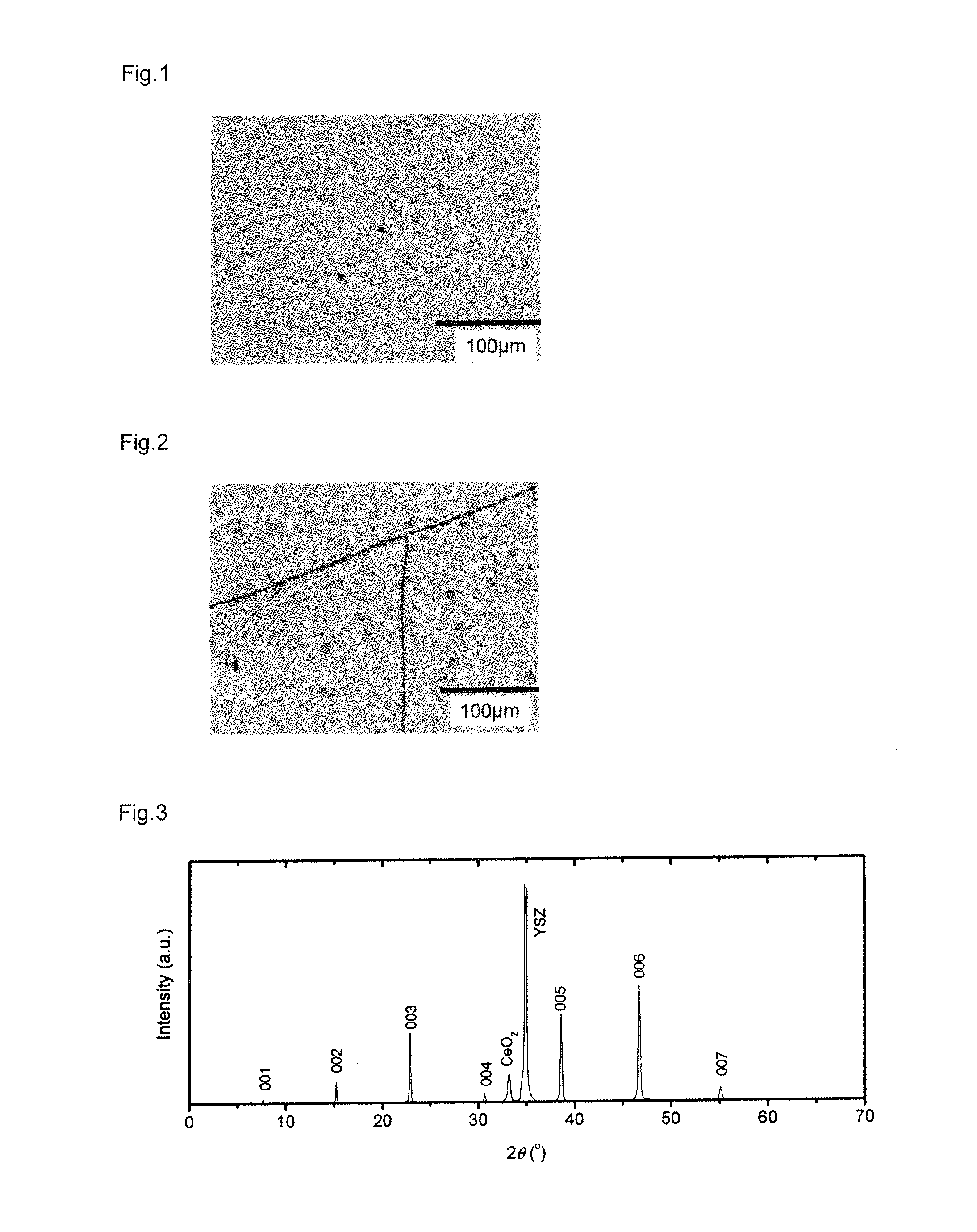Solution for forming rare-earth superconductive film and production method thereof
a technology of rare earths and superconductive films, applied in the direction of liquid/solution decomposition chemical coatings, non-metal conductors, conductors, etc., can solve the problems of generating hydrogen fluoride, reducing the efficiency of heat treatment, and reducing the number of heat treatment processes for eliminating organic components. , the effect of reducing the cos
- Summary
- Abstract
- Description
- Claims
- Application Information
AI Technical Summary
Benefits of technology
Problems solved by technology
Method used
Image
Examples
example 1
Preparation of Calcined Film
[0054]Metal acetylacetonate powders of commercially available yttrium, barium and copper (manufactured by Nihon Kagaku Sangyo Co., Ltd.) were weighed so that the molar ratio of the metal components becomes 1:2:3, and mixed to obtain a powder mixture. Pyridine and propionic acid were added to the mixture in an amount until the entire powder mixture dissolved. The product was subject to evaporation to eliminate the excess amount of pyridine and propionic acid, and an acetylacetonato group-propionic acid group-pyridine coordinated metal complex of an amorphous solid residue was obtained.
[0055]It was confirmed that this complex solid residue could be dissolved without leaving any precipitation in the solvent such as water or alcohol, and that a homogeneous solution could be obtained.
[0056]Subsequently, the product was dissolved in a mixed solvent of n-butanol and water to obtain a coating solution made from a liquid-state metal complex (including the three ty...
example 2
Preparation of Superconductor Film
[0067]The same method as Example 1 was used to prepare a calcined film, other than using an yttria stabilized zirconia single-crystal substrate in which cerium oxide was vacuum-deposited on the surface in advance, and using one among hexylene glycol, octylene glycol, and tetraethylene glycol as the additive agent.
[0068]The obtained calcined film was subject to the annealing process that was performed at 760° C. for 2 hours in a gas flow having an oxygen partial pressure of 10 Pa, and to the oxygenation process at an atmospheric pressure, whereby a Y123 superconductor film having a film thickness of 550 nm was prepared.
[0069]The Y123 film prepared as described above was observed with the naked eye and an optical microscope of ×40 to ×1000: it had no cracks in any of the cases. The results are shown in Table 3.
[0070]Moreover, the growth of a c-axis oriented film was confirmed in all cases via X-ray diffraction using the X-ray diffractometer of Mac Sci...
example 3
Preparation of Superconductor Film
[0074]The same method as Example 2 was used to prepare a Y123 superconductor film having a single-coat film thickness of 550 nm, other than setting the molar ratio of the metal components of yttrium, barium and copper to 1:2:3.7. The Y123 film prepared as described above was observed: it showed no cracks in any of the cases with the naked eye and an optical microscope of ×40 to ×1000, and the growth of a c-axis oriented Y123 film was confirmed via X-ray diffraction.
PUM
| Property | Measurement | Unit |
|---|---|---|
| thickness | aaaaa | aaaaa |
| thickness | aaaaa | aaaaa |
| thickness | aaaaa | aaaaa |
Abstract
Description
Claims
Application Information
 Login to View More
Login to View More - R&D
- Intellectual Property
- Life Sciences
- Materials
- Tech Scout
- Unparalleled Data Quality
- Higher Quality Content
- 60% Fewer Hallucinations
Browse by: Latest US Patents, China's latest patents, Technical Efficacy Thesaurus, Application Domain, Technology Topic, Popular Technical Reports.
© 2025 PatSnap. All rights reserved.Legal|Privacy policy|Modern Slavery Act Transparency Statement|Sitemap|About US| Contact US: help@patsnap.com


